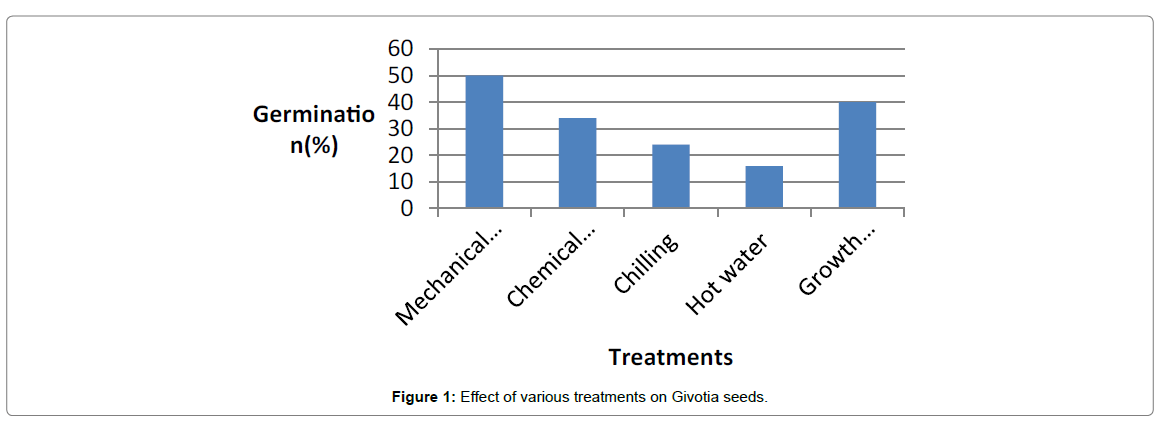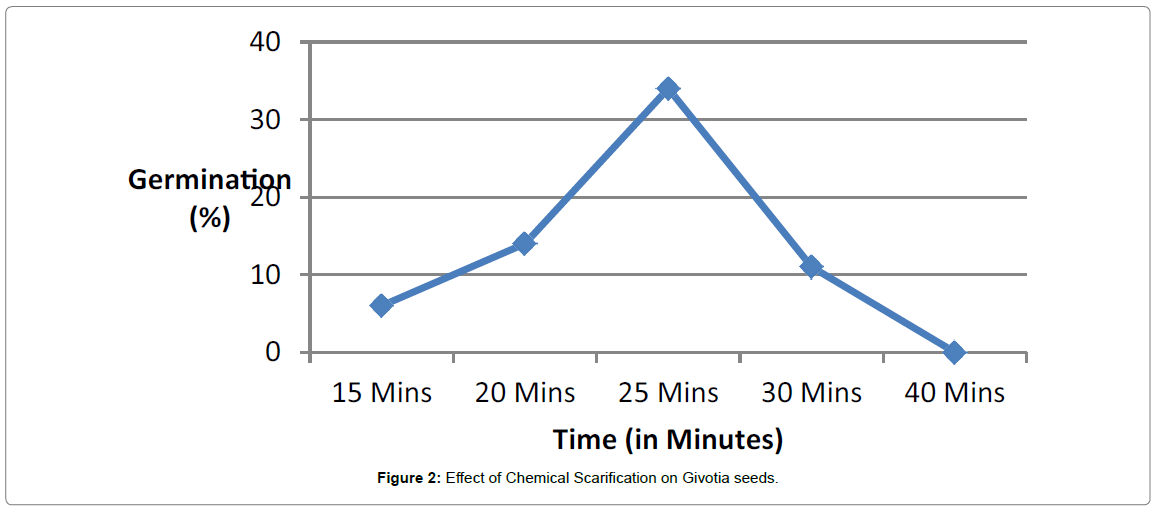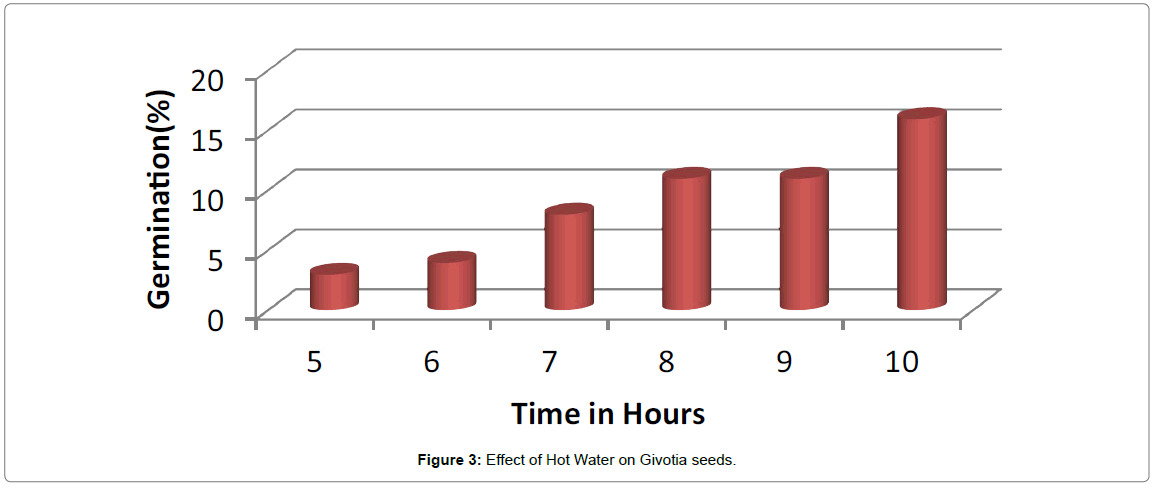Treatments to Break Seed Dormancy in Givotia rottleriformis Griff
Received: 22-Mar-2017 / Accepted Date: 20-Apr-2017 / Published Date: 27-Apr-2017 DOI: 10.4172/2329-8863.1000273
Abstract
The propagation of Givotia rottlerformis Griff is troublesome as consequence of it is long seed dormancy associated with poor seed germination. The breaking of seed dormancy is administered by environmental factors, including temperature, light, nitrate, and smoke constituents. Givotia seeds were treated with Scarification, Chilling, Hot water and Growth regulators in order to break its dormancy and enhance the germination percentage. The maximum seed germination percentage (50%) was obtained when seeds treated by Mechanical Scarification.
Keywords: Seed dormancy; Givotia rottlerformis Griff; Growth regulators; Seed germination
406443Introduction
Seed dormancy is described as a state in which seeds are kept from developing even under environmental conditions commonly favourable for germination. These conditions are complex combination mix of water, light, temperature, gasses, mechanical confinements, seed coats, and hormone structures. Living, non dormant seeds germinate when soil temperature and clamminess conditions are suited for cell process and division. Dormancy is caused by conditions inside the seed that foresee germination under usually idealize conditions. Consistently seed dormancy is separated into two essential classes in light of what some part of the seed produces dormancy: exogenous and endogenous [1]. There are three types of dormancy in perspective of their technique for action: physical, physiological and morphological. Techniques like Scarification, Soaking, Low Temperature (Chilling), Stratification, Treatments with growth regulators are used for faster and desired results. The present study was carried out with the objective to perform Scarification, Chilling, Hot water and Growth regulators (GA3) on Givotia seeds to break prolonged seed dormancy and to enhance its germination percentage, for its mass propagation and conservation [2].
Materials and Methods
Initial treatment
New seeds were collected from Givotia rottleriformis ranch RFRC Rajahmundry. After collection of seeds then washed and soaking in icy water for evacuating phenols and flavonoids [3]. Black water removed every day and filled with fresh water till phenols were expelled.
Mechanical scarification
In this treatment weakening of 50 Givotia seeds by mechanical abrasions mechanically, the abrasions caused by machine threshing causes mechanical scarification of stiff endocarp of the seeds. Mechanical scarification treatment was carried out by spinning the handle of the instrument, till the hard endocarps became thin and shiny, but not pierced [4]. After the Seeds Soaked in fresh water for 10 hours and then treated with 10% Clorox for 15 miutes as surface sterilization. Later the seeds treated with chemicals like potassium nitrate, Thiourea, Ethylene, Chlorohydrine to make the seed coats soft and weak. After this treatment seeds were sown into the beds.
Chemical scarification
Givotia seeds soaked in concentrated sulphuric acid for 15 minutes, 20 minutes, 25 minutes and 30 minutes respectively. Seeds and acid solution mixed at 1:2 ratio, it will remove seed coat impermeability. After this treatment seeds are sown into the beds.
Chilling
Surface sterilized Givotia seeds mixed with coco peat in 1:3 ratio. The mixture placed in pitted plastic bags and incubated at 15°C for 1500 hours [5]. After stratification period, seeds washed and sowed in plastic bags (20 × 25 cm) containing a mixture of sand, soil and peat (1:1:1 ratio). Seeds placed in 2 cm depth of the media uniformly (one seed per pot) then bags placed in a refrigerator just above freezing (0-5°C) for 24 hours. After this treatment seeds were sown into beds [6].
Hot water treatment
In this treatment the seeds are immersed in 40-60°C of hot water For 5,6,7, 8,9 hours and 10 hours respectively then the seeds were incubated in glass jars for 24 hours after incubation period the seeds are sown into beds [7].
Treatment with growth regulators
Endogenous dormancy may be a result of proximity of Germination inhibitors. Use of low level of growth regulators (i.e., Gibberellins, Cytokinins and Ethylene, etc.) may break the seed dormancy. Most commonly used growth regulators are gibberellins and kinetics presoaking seed treatment with GA3 at the conc. Of 100 ppm have been used for breaking seed dormancy [8]. Among various chemicals potassium nitrate (0.2%) and thio-urea (0.5 to 3%) are commonly used for breaking seed dormancy. (For prepare 100 ppm solution of GA3, weigh 100 mg of GA3 and dissolve in two or three drops of alcohol and make up the last volume (1000 ml) by adding distilled water). (50 ppm kinetin 5 mg dissolved in few drops of alkaline made with sodium hydroxide and makes the final volume 100 ml it gives to final last conc. of 50 ppm) [9]. Now the surface sterilised Givotia seeds were subjected to treat with GA3 100 ppm soaking for 24 hours then the seeds were sown into beds.
Results and Discussion
Endocarp layer of Givotia fruits surrounding the seeds is a complex hard woody structure preventing penetration of moisture and gases into the seed and hinders development of embryo. Breaking down of this layer by mechanical Scarification or chemical treatments leads to perforation of water nutrients to activation of embryos. In this study, breaking the dormant stage and increase in seed germination of Givotia seeds following scarification, both Mechanical and Chemical and treatment with hot water and chilling treatments and treatment with Growth regulator GA3 is due to softening and increase in permeability of the endocarp [10,11]. Seeds need to absorb water and interchange of gases during the stratification time (Table 1). Seeds scarification treatments minimize the hard structures surrounded seeds and helps more water absorption and gases exchange by seeds and may improve stratification efficiency [12].
| S No | Name of the species | Date of seed collection | Treatments | Dater of sowing | No. of seeds sown | No.of seeds germinated | % of germination |
|---|---|---|---|---|---|---|---|
| 1 | Givotia rottleriformis | 20-Feb-13 | Mechanical Scarification | 22-Feb-13 | 50 | 25 | 50 |
| 2 | 20-Feb-13 | Chemical Scarification | 23-Feb-13 | 50 | 17 | 34 | |
| 3 | 20-Feb-13 | Chilling | 23-Feb-13 | 50 | 12 | 24 | |
| 4 | 20-Feb-13 | Hot Water Treatment | 26-Feb-13 | 50 | 8 | 16 | |
| 5 | 20-Feb-13 | Treatment with Growth regulators | 4-Mar-13 | 50 | 23 | 40 |
Table 1: Treatments on Givotia seeds.
Seed germination and early growth of Givotia seedlings after Chemical Scarification (Conc H2SO4) treatments were much better than the treatment with Hot water. Hot water did not affect germination and early growth of Givotia seedlings (Figure 1). Chemical Scarification is successful in removal of hard seed coat and increases the germination, since the acid had similar effect as that of natural degradation of the testa by microbial action in the soil [13]. 34% of seed germination observed after the successful treatment with acid scarification for 25 minutes.
When compared to Hot water treatment Givotia seeds were germinated in good number (24%) after Chilling treatment this may be due to low icy conditions creates favourable conditions for seed germination. Maximum percentage of seed germination of Givotia achieved after seeds were carefully treated by Mechanical Scarification [14]. This may be due to removal of endocarp layer by machine threshing involves areful removal of seed coat by making destructions to seed coat away from the embryo and it will help seeds to expose the environmental factors i.e., light temperature moisture etc.
Similarly, seeds treated with GA3 also increased the germination (40%) and this may due to the activation of enzymes required for the energy supply leading to the growth of the embryo (Figure 2). Growth harmones release enzymes that breakdown carbohydrates and proteins results release free sugars and counteracts with inhibitors [15]. 50 Givotia seeds were treated by concentrated H2SO4 in 5 different time intervals 15, 20, 25, 30 and 40 minutes respectively, maximum 34% seed germination achieved after seeds were treated for 25 minutes [16]. There was no germination observed at 40 minutes this may be due to high concentration of acid destroyed the ability of seed germination (Figure 3). 16% of seed germination observed when 50 seeds were treated with Hot water 40-60°C for 10 hours. Soaking in Hot water for long time increasing in germination, this is due to weakening of hard seed coat by hot water and became permeable and exchange of gases and liquids into seeds.
Conclusion
The results of the current study showed that successful utilization of Scarfication (Mechanical and Chemical), Chilling treatment with growth regulators and Hot water treatments used to overcome the problem of prolonged seed dormancy in Givotia rottleriformis Griff. Mechanical Scarification significantly increased seed germination. Treatment with growth regulator GA3 has also been shown as the finer method to overcome seed coat dormancy.
References
- Baskin JM, Baskin CC (2004) A classiï¬cation system for seed dormancy. Seed Science Research 14: 1-16.
- Black M, Bewley JD, Halmer P (2006) The Encyclopedia of seeds. CAB International,Wallingford, Oxfordshire.
- Birgit K, Cohn MA, Leubner MG (2005) Plant hormones interaction during dormancy release and germination. Seed Sci Res 15:281-307.
- Hartmann HT, Kester DE, Davies FT, Greeve RL (2001) Principles and Practices of Plant Propagation. 6th edn. Prentice Hall Publishers, London, UK.
- Herranz JM, Ferrands Z, Martinez SJJ (1998)Â Influence of heat on seed germination of seven Mediterranean leguminosae species. Plant Ecol 135: 95-103.
- Bewley J, Derek D, Michael B (1994) Physiology of development and germination. Seeds, Plenum Press, New York, USA.
- Lee SY, Lee JH, Kwon TO (2002) Varietal differences in seed germination and seedling vigor ofKorean rice varieties following dry heat treatments.Seed Sci Technol 30: 311-321.
- Ikechukwu OA, Gordian CO (1992) Breeding system and pollination ecology of two Abrus species (Fabaceae) from Tropical West Africa. Acta Bot Croat 66:205-216.
- Quinlivan BJ, Millington AJ (1962). The effect of a Mediterranean summer environment on the permeability of hard seeds of subterranean clover. Aust J Agric Res 13:377-387.
- Van SJ, Kelly KM, Bell WE (1994) The role of natural agents in the removal of coat-imposed dormancy in Dichrostachys cinerea (L.) Wight et Arn seeds. Plant Growth Regul 14:51-59.
- Mary RC (1972) Tannins as gibberellins antagonists. Plant Phy 49: 323-330.
- McCowan B, Lloyd GB (1981) Woody plant medium (WPM)-a mineralnutrients formulation for microculture of woody plant species.HortScience 16: 453.
- Rambabu M, Ujjwala D, Ugandhar T, Praveen M, Upender M, et al.(2005)Â Effect of GA3on enhancement of in vivo seed germination in Givotia rottleriformis (Euphorbiaceae) - an endangered forest tree.Indian For 131: 25-30.
- Sotomayor-Leon EM, Cabalero JM(1990) An easy method of breaking olive stones to remove mechanical dormancy. Acta Hortic 286: 113-116.
- Murthy JSN(1992) Trials on vegetative propagation by stem cuttings in Punikitree (Givotia rottleriformis). In: Reddy KK (ed.), Vegetative and biotechnologies for tree improvement. Natraj Publishers, Dehradun, pp: 27-30.
- Voyiatzis DG, Porlingis IC(1987) Temperature requirements for the germination of olive seeds. J Hortic Sci 62: 405-411.
Citation: Jetti A, Jetti J, Perla R (2017) Treatments to Break Seed Dormancy in Givotia rottleriformis Griff. Adv Crop Sci Tech 5: 273. DOI: 10.4172/2329-8863.1000273
Copyright: © 2017 Jetti A, et al. This is an open-access article distributed under the terms of the Creative Commons Attribution License, which permits unrestricted use, distribution, and reproduction in any medium, provided the original author and source are credited.
Share This Article
Recommended Journals
Open Access Journals
Article Tools
Article Usage
- Total views: 15590
- [From(publication date): 0-2017 - Apr 03, 2025]
- Breakdown by view type
- HTML page views: 14447
- PDF downloads: 1143



